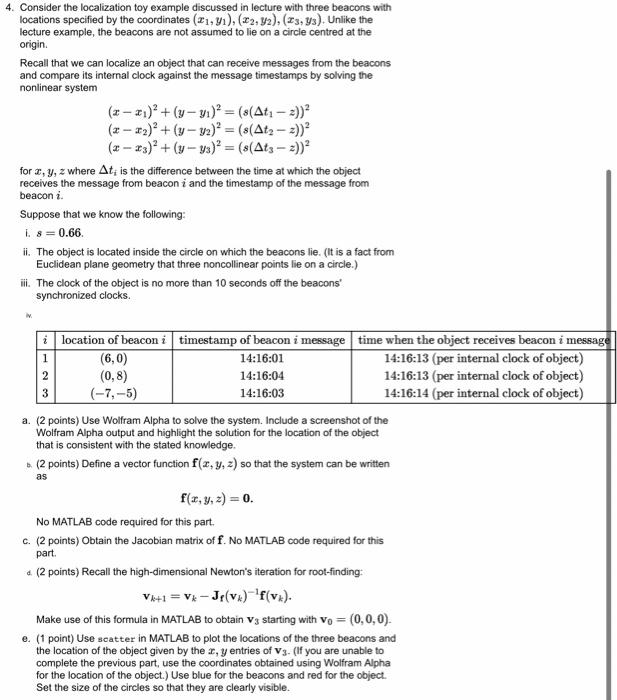Consider the localization toy example discussed in lecture with three beacons with locations specified by the coordinates (x1,y1),(x2,y2),(x3,y3). Unlike the lecture example, the beacons are not assumed to lie on a circle centred at the origin. Recall that we can localize an object that can receive messages from the beacons and compare its internal clock against the message timestamps by solving the nonlinear system (xx1)2+(yy1)2=(s(t1z))2(xx2)2+(yy2)2=(s(t2z))2(xx3)2+(yy3)2=(s(t3z))2 for x,y,z where ti is the difference between the time at which the object receives the message from beacon i and the timestamp of the message from beacon i. Suppose that we know the following: i. s=0.66. ii. The object is located inside the circle on which the beacons lie. (It is a fact from Euclidean plane geometry that three noncollinear points lie on a circle.) iii. The clock of the object is no more than 10 seconds off the beacons" synchronized clocks. a. (2 points) Use Wolfram Alpha to solve the system. Include a screenshot of the Wolfram Alpha output and highlight the solution for the Iocation of the object that is consistent with the stated knowledge. b. (2 points) Define a vector function f(x,y,z) so that the system can be written as f(x,y,z)=0. No MATLAB code required for this part. c. (2 points) Obtain the Jacobian matrix of f. No MATLAB code required for this part. 4. (2 points) Recall the high-dimensional Newton's iteration for root-finding: vk+1=vkJf(vk)1f(vk). Make use of this formula in MATLAB to obtain v3 starting with v0=(0,0,0). e. (1 point) Use seatter in MATLAB to plot the locations of the three beacons and the location of the object given by the x,y entries of v3. (If you are unable to complete the previous part, use the coordinates obtained using Wolfram Alpha for the location of the object.) Use blue for the beacons and red for the object. Set the size of the circles so that they are clearly visible. Consider the localization toy example discussed in lecture with three beacons with locations specified by the coordinates (x1,y1),(x2,y2),(x3,y3). Unlike the lecture example, the beacons are not assumed to lie on a circle centred at the origin. Recall that we can localize an object that can receive messages from the beacons and compare its internal clock against the message timestamps by solving the nonlinear system (xx1)2+(yy1)2=(s(t1z))2(xx2)2+(yy2)2=(s(t2z))2(xx3)2+(yy3)2=(s(t3z))2 for x,y,z where ti is the difference between the time at which the object receives the message from beacon i and the timestamp of the message from beacon i. Suppose that we know the following: i. s=0.66. ii. The object is located inside the circle on which the beacons lie. (It is a fact from Euclidean plane geometry that three noncollinear points lie on a circle.) iii. The clock of the object is no more than 10 seconds off the beacons" synchronized clocks. a. (2 points) Use Wolfram Alpha to solve the system. Include a screenshot of the Wolfram Alpha output and highlight the solution for the Iocation of the object that is consistent with the stated knowledge. b. (2 points) Define a vector function f(x,y,z) so that the system can be written as f(x,y,z)=0. No MATLAB code required for this part. c. (2 points) Obtain the Jacobian matrix of f. No MATLAB code required for this part. 4. (2 points) Recall the high-dimensional Newton's iteration for root-finding: vk+1=vkJf(vk)1f(vk). Make use of this formula in MATLAB to obtain v3 starting with v0=(0,0,0). e. (1 point) Use seatter in MATLAB to plot the locations of the three beacons and the location of the object given by the x,y entries of v3. (If you are unable to complete the previous part, use the coordinates obtained using Wolfram Alpha for the location of the object.) Use blue for the beacons and red for the object. Set the size of the circles so that they are clearly visible







